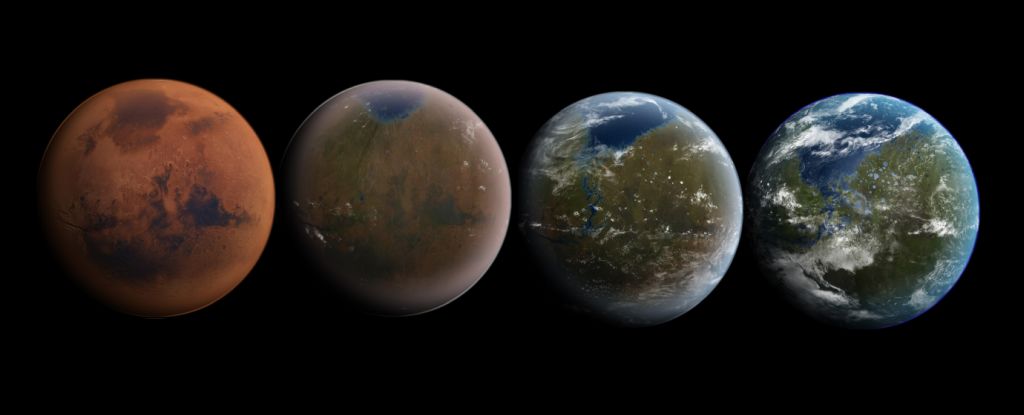If we ever want to set up long-term human colonies on Mars, there are going to have to be changes. Mars is not exactly the most hospitable place in the Solar System, and the current situation over there is not optimum for survival.
Not least among the problems is the climate. Mars’s temperatures dip way too low for the comfort of warm human bodies – the median sits at -64 degrees Celsius (-85 Fahrenheit). If we want to terraform, we need to heat things up.
Now, scientists have found a way to do just that, and they claim their method is 5,000 times more efficient than other strategies.
According to a team led by electrical engineer Samaneh Ansari of Northwestern University in the US, Mars could be warmed and kept warm by releasing nanoscopic metal rods into the atmosphere to create and maintain a greenhouse effect.
“You’d still need millions of tons to warm the planet, but that’s five thousand times less than you would need with previous proposals to globally warm Mars. This significantly increases the feasibility of the project,” says geophysicist Edwin Kite of the University of Chicago, corresponding author on the research.
“This suggests that the barrier to warming Mars to allow liquid water is not as high as previously thought.”
The greenhouse effect is the most feasible way we know to warm up a planet, but in spite of Earth’s situation, it’s actually harder to generate than it seems. Previously proposed strategies for the greenhouse warming of Mars has invoked the need for greenhouse gasses, like those that warm Earth and Venus.
Here on Earth, greenhouse warming has proven much too easy. The atmosphere becomes filled with gasses such as carbon dioxide and methane which scatters heat radiating from the surface, slowing its escape into space and causing temperatures to rise.
If we could pump Mars’ tenuous atmosphere with these greenhouse gasses, as per previous proposals, the warming effect would follow, raising the temperature of Mars to a level where photosynthetic organisms could survive.
The problem is that Mars doesn’t have a lot of the ingredients needed for this strategy. We’d either have to ferry it from Earth in huge quantities, or try to mine it from under the surface of Mars. Either way is expensive and difficult.
But what if we worked with what Mars does have readily available? Its surface soil, Martian rovers have ascertained, is rich with metallic minerals such as aluminum and iron. What if we could blast tiny particles of sparkling metal into the Martian atmosphere like a glitter cannon, to be borne aloft and trap sunlight, the way carbon emissions do here on Earth?
Ansari and her colleagues modeled tiny metallic rods the same size as the dust particles native to Mars, a little bit smaller than commercial glitter, with an aspect ratio of 60:1, to be released into the Martian sky. They calculated how much heat would be trapped by glittering metallic clouds of these nanorods, and how much dust would be required to produce and maintain a greenhouse effect.
The size and shape of the nanorods would keep the dust from falling down to Mars for 10 times longer than natural dust. If released at a sustained rate of 30 liters per second, the nanorods would produce the aforementioned warming, causing surface ice to melt and raising atmospheric pressure as carbon dioxide ice sublimes.
Atmospheric pressure would continue to increase over centuries as polar carbon dioxide ice caps volatilized.
This would not make Mars habitable by a long shot. There would still be insufficient oxygen in Mars’ atmosphere to be breathable; but, once the surface is habitable to bacteria, microbes could be installed to start the long, difficult job of oxygen production.
The nanorod strategy would still take quite some time, in the range of several decades, but would ultimately warm Mars by more than 28 degrees Celsius, pushing its climate into a regime still not comfy for vertebrates, but warm enough for photosynthetic microbial life – a first important step towards a terraformed Mars.
There are also still some problems that might need to be resolved. It’s not clear how long the nanorods would remain in Mars’ atmosphere, which continues to leak into space (that’s not unusual; all atmospheres are leaky, but Mars doesn’t have a global magnetic field providing containment like Earth does).
And, as Mars warmed, the nanoparticles could end up attracting water particles, like dust does in Earth’s atmosphere, and fall back down to the surface as rain. So it may not stay airborne for as long as we might like. This presents a potential speed bump that we don’t quite know how to predict, and will require further study.
Nevertheless, “This research opens new avenues for exploration and potentially brings us one step closer to the long-held dream of establishing a sustainable human presence on Mars,” Kite says.
The research has been published in Science Advances.





